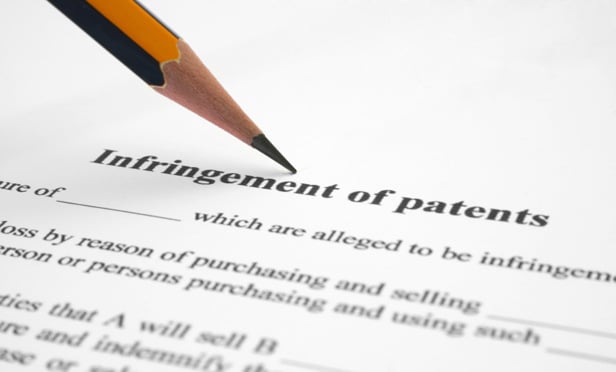Features

The Basics When Reviewing a Real Estate Tax Provision
There are several clauses that rarely find their way into a landlord's initial draft of the lease that may be beneficial to a tenant. In addition, certain real estate tax provisions that are typically included in a landlord's standard lease form need to be carefully reviewed to make sure they are fair to both the landlord and the tenant.
Features

Recreational Marijuana in New Jersey
<b><i>Real Estate and Other Issues Will Need Consideration</b></i><p>Given NJ Governor Phil Murphy's campaign pledge to legalize marijuana for recreational use in his first 100 days, the state is on the cusp of a major new revenue stream-recreational marijuana.
Features

Even the Value of the Smallest Salable Unit Must Be Apportioned
<i><b>Finjan, Inc. v. Blue Coat Sys., Inc.</b></i><p>The Federal Circuit ruled that basing a reasonable royalty calculation on the “smallest salable unit” does not obviate the need to apportion damages to the patented contribution within that unit.
Features

What Retailers Can Learn from Recent Bankruptcies
Understanding the factors leading up to these bankruptcies, as well as the strategies used by retailers to emerge from bankruptcy, can give retailers significant knowledge about trends in consumer spending and how retailers can improve their overall positions going forward.
Features

Monk Estate Suit Against Beer Co. Moves Forward
A Northern California craft brewery lost an early attempt to knock out a lawsuit brought by the son of jazz legend Thelonious Monk, who claims the brewery uses Monk's name and likeness without permission.
Columns & Departments

Development
Failure to Require SEIS Not Arbitrary<br>Board of Fire Commissioners Lacks Standing to Challenge SEQRA Determination<br>Challenge to Pilot Agreement Reinstated<br>Statute of Limitations Bars Challenge to Excessive Height<br>Billboard Regulation Upheld
Features

Wells Fargo, Ending Its Appeal, Settles Whistleblower's $577K Retaliation Case
Wells Fargo & Co. has reached a settlement with a former branch manager who claimed she was fired for blowing the whistle on employees who had been opening accounts without permission, the sales-pressure conduct at issue in a scandal that erupted in 2016.
Features

<i>e-Discovery:</i> Four Cases Highlighting e-Discovery Trends in the Second Half of 2017
In the second half of 2017, case law served to clarify what does and does not constitute reasonable policies and procedures for preserving information subject to discovery — as well as the risks you run if you fail to follow through on those policies.
Features

Serving Two Masters: When 'Bankruptcy Remote' Meets Public Policy
<i><b>How Lenders to BREs Can Reduce the Risk of Debtor Bankruptcy Without Compromising Public Policies</b></i><p>Structured financing transactions, including those pertaining to commercial real estate, make extensive use of entities formed for the specific purpose of reducing the likelihood that assets will be involved in a potential bankruptcy proceeding. Known as “bankruptcy-remote entities,” or “BREs,” these entities are subject to structures and covenants in financing documents and their own formation documents, which are designed to reduce the likelihood that the BRE will file for bankruptcy protection.
Columns & Departments

Bit Parts
“Dead Man Statute” No Bar to Testimony About Alleged Oral Contract for Share of Royalties from Ben E. King Songs<br>Eleventh Circuit Sees No Personal Jurisdiction in Malpractice Lawsuit Against Law Firm that Handled Concert Industry Litigation<br>Tax Court Finds No Profit Motive in Music Club Operation
Need Help?
- Prefer an IP authenticated environment? Request a transition or call 800-756-8993.
- Need other assistance? email Customer Service or call 1-877-256-2472.
MOST POPULAR STORIES
- The 'Sophisticated Insured' DefenseA majority of courts consider the <i>contra proferentem</i> doctrine to be a pillar of insurance law. The doctrine requires ambiguous terms in an insurance policy to be construed against the insurer and in favor of coverage for the insured. A prominent rationale behind the doctrine is that insurance policies are usually standard-form contracts drafted entirely by insurers.Read More ›
- A Lawyer's System for Active ReadingActive reading comprises many daily tasks lawyers engage in, including highlighting, annotating, note taking, comparing and searching texts. It demands more than flipping or turning pages.Read More ›
- The Brave New World of Cybersecurity Due Diligence in Mergers and Acquisitions: Pitfalls and OpportunitiesLike poorly-behaved school children, new technologies and intellectual property (IP) are increasingly disrupting the M&A establishment. Cybersecurity has become the latest disruptive newcomer to the M&A party.Read More ›
- Abandoned and Unused Cables: A Hidden Liability Under the 2002 National Electric CodeIn an effort to minimize the release of toxic gasses from cables in the event of fire, the 2002 version of the National Electric Code ("NEC"), promulgated by the National Fire Protection Association, sets forth new guidelines requiring that abandoned cables must be removed from buildings unless they are located in metal raceways or tagged "For Future Use." While the NEC is not, in itself, binding law, most jurisdictions in the United States adopt the NEC by reference in their state or local building and fire codes. Thus, noncompliance with the recent NEC guidelines will likely mean that a building is in violation of a building or fire code. If so, the building owner may also be in breach of agreements with tenants and lenders and may be jeopardizing its fire insurance coverage. Even in jurisdictions where the 2002 NEC has not been adopted, it may be argued that the guidelines represent the standard of reasonable care and could result in tort liability for the landlord if toxic gasses from abandoned cables are emitted in a fire. With these potential liabilities in mind, this article discusses: 1) how to address the abandoned wires and cables currently located within the risers, ceilings and other areas of properties, and 2) additional considerations in the placement and removal of telecommunications cables going forward.Read More ›
- Guidance on Distributions As 'Disbursements' and U.S. Trustee FeesIn a recent case from the Bankruptcy Court for the District of Delaware, In re Paragon Offshore PLC, the bankruptcy court provided guidance on whether a post-plan effective date litigation trust's distributions constituted disbursements subject to the U.S. Trustee fee "tax."Read More ›
